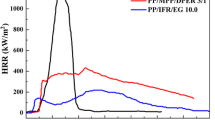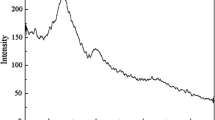Abstract
In order to enhance the flame retardancy of intumescent flame retardant (IFR) in polypropylene (PP) using synergistic effects, a three-dimensional flower-like nickel cobaltate (NiCo2O4) was prepared and first introduced into the PP/IFR composite. The combustion behavior, thermal stability, mechanical properties and hydrophobicity of PP/IFR containing NiCo2O4 are studied in detail. When the contents of NiCo2O4 and IFR are 1.5 wt% and 18.5 wt%, respectively, the limit oxygen index value of the PP composite reaches 34.5 and passes the UL-94V-0 level. The cone calorimetry test also reveals that NiCo2O4 plays an excellent synergistic role with IFR, resulting in a significant improvement in the flame retardancy of the PP composite. Compared with pure PP, the presence of 1.5 wt% of NiCo2O4 delays combustion, decreases the peak heat release rate and total heat release by 64% and 40%, respectively, as well as exhibits a significant smoke suppression effect. At high temperature, the residual char of the PP composite is increased, and the degree of graphitization of corresponding char is also improved, both of which contribute to forming a continuous dense stable char layer and acquire a better shielding effect. The presence of NiCo2O4 only has a slight negative effect on the tensile strength of the PP composite. Interestingly, the hydrophobicity of the PP composite at this ratio is improved to some extent compared with that of the composite containing only 20 wt% IFR; thus, the synergistic flame-retardant effect is also ensured in the water resistance test within a certain time.
Graphic abstract









Similar content being viewed by others
References
Li J, Lai X, Li H, Zeng X, Liu Y, Zeng Y, Jiang C (2019) Functionalized ZrP nanosheet with free-radical quenching capability and its synergism in intumescent flame retardant polypropylene. Polym Adv Technol 31(3):602–615
Sun Y, Yuan B, Shang S, Zhang H, Shi Y, Yu B, Qi C, Dong H, Chen X, Yang X (2020) Surface modification of ammonium polyphosphate by supramolecular assembly for enhancing fire safety properties of polypropylene. Compos B Eng 181:107588–107599
Zhang S, Horrocks AR (2003) A review of flame retardant polypropylene fibres. Prog Polym Sci 28(11):1517–1538
Wang J, Wang L, Xiao A (2009) Recent research progress on the flame-retardant mechanism of halogen-free flame retardant polypropylene. Polym Plast Technol Eng 48(3):297–302
Lim K-S, Bee S-T, Sin LT, Tee T-T, Ratnam CT, Hui D, Rahmat AR (2016) A review of application of ammonium polyphosphate as intumescent flame retardant in thermoplastic composites. Compos B Eng 84:155–174
Wang Z, Liu Y, Li J (2017) Regulating effects of nitrogenous bases on the char structure and flame retardancy of polypropylene/intumescent flame retardant composites. ACS Sustain Chem Eng 5(3):2375–2383
Chen X, Huang C, Shi Y, Yuan B, Sun Y, Bai Z (2019) MoO3–ZrO2 solid acid for enhancement in the efficiency of intumescent flame retardant. Powder Technol 344:581–589
Ding S, Liu P, Gao C, Wang F, Ding Y, Zhang S, Yang M (2019) Synergistic effect of cocondensed nanosilica in intumescent flame-retardant polypropylene. Polym Adv Technol 30(4):1116–1125
Qin Z, Yang R, Zhang W, Li D, Jiao Q (2019) Synergistic barrier effect of aluminum phosphate on flame retardant polypropylene based on ammonium polyphosphate/dipentaerythritol system. Mater Des 181:107913–107923
Lewin M, Endo M (2003) Catalysis of intumescent flame retardancy of polypropylene by metallic compounds. Polym Adv Technol 14(1):3–11
Song R, Zhang B, Huang B, Tang T (2006) Synergistic effect of supported nickel catalyst with intumescent flame-retardants on flame retardancy and thermal stability of polypropylene. J Appl Polym Sci 102(6):5988–5993
Dong X, Nie S, Liu Z, Wang D-Y (2016) Study of the synergistic effect of nickel phosphate nanotubes (NiPO-NT) on intumescent flame retardant polypropylene composites. J Therm Anal Calorim 126(3):1323–1330
Wu N, Ding C, Yang R (2010) Effects of zinc and nickel salts in intumescent flame-retardant polypropylene. Polym Degrad Stab 95(12):2589–2595
Yu Y, Song PA, Jin C, Fu S, Zhao L, Wu Q, Ye J (2012) Catalytic effects of nickel (cobalt or zinc) acetates on thermal and flammability properties of polypropylene-modified lignin composites. Ind Eng Chem Res 51(38):12367–12374
Wu N, Yang R (2011) Effects of metal oxides on intumescent flame-retardant polypropylene. Polym Adv Technol 22(5):495–501
Han L, Wu W, Qi Y, Qu H, Xu J (2017) Synergistic flame retardant effect of BiFeO3 in intumescent flame-retardant polypropylene composites. Polym Compos 38(12):2771–2778
Sheng Y, Chen Y, Bai Y (2014) Catalytically synergistic effects of novel LaMnO3 composite metal oxide in intumescent flame-retardant polypropylene system. Polym Compos 35(12):2390–2400
Shen Y, Gong W, Zheng B, Meng X, Gao L (2016) Synergistic effect of Ni-based bimetallic catalyst with intumescent flame retardant on flame retardancy and thermal stability of polypropylene. Polym Degrad Stab 129:114–124
Chen D, Pang D, Zhang S, Song H, Zhu W, Zhu J (2020) Synergistic coupling of NiCo2O4nanorods onto porous Co3O4nanosheet surface for tri-functional glucose, hydrogen-peroxide sensors and supercapacitor. Electrochim Acta 330:135326–135337
Yang C-C, Sun W-C, Kumar A, Pattanayak B, Tseng T-Y (2019) Templating synthesis of nickel cobaltite nanoflakes and their nanocomposites for making high-performance symmetric supercapacitors. Mater Today Energy 14:100356–100368
Chen H, Zheng Y, Cheng B, Yu J, Jiang C (2018) Chestnut husk-like nickel cobaltite hollow microspheres for the adsorption of Congo red. J Alloys Compd 735:1041–1051
Rahimi M, Gh AB, Fatemi SJ (2019) A new sensor consisting of bird nest-like nanostructured nickel cobaltite as the sensing element for electrochemical determination of doxorubicin. J Electroanal Chem 848:113333–113341
Qiao M, Wang Y, Li L, Hu G, Zou G, Mamat X, Dong Y, Hu X (2019) Self-templated nitrogen-doped mesoporous carbon decorated with double transition-metal active sites for enhanced oxygen electrode catalysis. Rare Metals 39:824–833
Lia J, Wang Z, Xua H, Li H, Yang Y, Jian Z, Xing Y, Zhang S, Ren Y (2019) Sea urchin-like Co3O4@Pdnanoneedles with 3D open-structured matrix as efficient catalytic cathode for Li-O2 batteries. Solid State Ion 343:115075–115086
Lan D, Qin M, Liu J, Wu G, Zhang Y, Wu H (2020) Novel binary cobalt nickel oxide hollowed-out spheres for electromagnetic absorption applications. Chem Eng J 382:122797–122809
Qin M, Lan D, Wu G, Qiao X, Wu H (2020) Sodium citrate assisted hydrothermal synthesis of nickel cobaltate absorbers with tunable morphology and complex dielectric parameters toward efficient electromagnetic wave absorption. Appl Surf Sci 504:144480–144492
Kulandaivalu S, Hussein MZ, Mohamad Jaafar A, MohdAbdah MAA, Azman NHN, Sulaiman Y (2019) A simple strategy to prepare a layer-by-layer assembled composite of Ni–Co LDHs on polypyrrole/rGO for a high specific capacitance supercapacitor. RSCAdv 9(69):40478–40486
Xue C, Chen Y, Li Y, Chen H, Cui D, Lin L (2019) NiCo2O4@TiO2 electrode based on micro-region heterojunctions for high performance supercapacitors. Appl Surf Sci 493:994–1003
Yavuz E, Tokalıoğlu Ş, Şahan H, Berberoğlu A, Patat Ş (2017) Vortexing/shaking-free solid phase extraction of lead(II) by using an urchin-like NiCo2O4 hollow microsphere adsorbent. Microchim Acta 184(4):1191–1198
Zhi L, Xu Y, Zhang S, Hu D, Liu J (2020) Hierarchically porous BiOCl@NiCo2O4nanoplates as low-cost and highly efficient catalysts for the discoloration of organic contaminants in aqueous media. New J Chem 44(1):258–264
Jiang W, Hu F, Yan Q, Wu X (2017) Investigation on electrochemical behaviors of NiCo2O4 battery-type supercapacitor electrodes: the role of an aqueous electrolyte. Inorg Chem Front 4(10):1642–1648
Wang J, Yuan B, Mu X, Wang W, Hu W, Hu Y (2016) Novel incorporation of mesoporousNiCo2O4 into thermoplastic polyurethane for enhancing its fire safety. RSCAdv 6(111):109620–109632
Qin Z, Li D, Li Q, Yang R (2016) Effect of nano-aluminum hydroxide on mechanical properties, flame retardancy and combustion behavior of intumescent flame retarded polypropylene. Mater Des 89:988–995
Yuan G, Yang B, Chen Y, Jia Y (2018) Preparation of novel phosphorus-nitrogen-silicone grafted graphene oxide and its synergistic effect on intumescent flame-retardant polypropylene composites. RSCAdv 8(63):36286–36297
He S, Hu Y, Song L, Tang Y (2016) Fire safety assessment of halogen-free flame retardant polypropylene based on cone calorimeter. J Fire Sci 25(2):109–118
Zhang Z, Li X, Yuan Y, Pan Y-T, Wang D-Y, Yang R (2019) Confined dispersion of zinc hydroxystannate nanoparticles into layered bimetallic hydroxide nanocapsules and its application in flame-retardant epoxy nanocomposites. ACS Appl Mater Interfaces 11:4095–40960
Yang W, Wu S, Yang W, Chun-Yin Yuen A, Zhou Y, Yeoh G, Boyer C, Wang CH (2020) Nanoparticles of polydopamine for improving mechanical and flame-retardant properties of an epoxy resin. Compos B Eng 186:107828–107838
Guo Z, Wang Z, Fang Z (2020) Fabrication of 9,10-dihydro-9-oxa-10-phosphaphenanthrene-10-oxide-decorated fullerene to improve the anti-oxidative and flame-retardant properties of polypropylene. Compos B Eng 183:107612–107640
Zhang Q, Li Z, Li X, Yu L, Zhang Z, Wu Z (2019) Zinc ferrite nanoparticle decorated boron nitride nanosheet: Preparation, magnetic field arrangement, and flame retardancy. Chem Eng J 356:680–692
Sun L, Xie Y, Ou R, Guo C, Hao X, Wu Q, Wang Q (2020) The influence of double-layered distribution of fire retardants on the fire retardancy and mechanical properties of wood fiber polypropylene composites. Constr Build Mater 242:118047–118055
Das SK, Jasuja K (2018) Chemical exfoliation of layered magnesium diboride to yield functionalized nanosheets and nanoaccordions for potential flame retardant applications. ACS Appl Nano Mater 1(4):1612–1622
Zhang L, Wang Q, Jian R-K, Wang D-Y (2020) Bioinspired iron-loaded polydopamine nanospheres as green flame retardants for epoxy resin via free radical scavenging and catalytic charring. J Mater Chem 8(5):2529–2538
Wei Y-X, Deng C, Wei W-C, Chen H, Wang Y-Z (2019) Hybrid nanorods composed of titanium, silicon, and organophosphorus as additives for flame-retardant polycarbonate. ACS Appl Nano Mater 2(8):4859–4868
Kim NK, Lin RJT, Bhattacharyya D (2017) Flammability and mechanical behaviour of polypropylene composites filled with cellulose and protein based fibres: a comparative study. Compos Part A 100:215–226
Shi H, Zhao X, Li Z, Yu L, Li X, Zhang Z (2019) Bismuth oxychloride nanosheets for improvement of flexible poly (vinyl chloride) flame retardancy. J Mater Sci 55(2):631–643. https://doi.org/10.1007/s10853-019-04048-9
Wu H, Zeng B, Chen J, Wu T, Li Y, Liu Y, Dai L (2019) An intramolecular hybrid of metal polyhedral oligomeric silsesquioxanes with special titanium-embedded cage structure and flame retardant functionality. Chem Eng J 374:1304–1316
Yuan B, Hu Y, Chen X, Shi Y, Niu Y, Zhang Y, He S, Dai H (2017) Dual modification of graphene by polymeric flame retardant and Ni(OH)2nanosheets for improving flame retardancy of polypropylene. Compos A Appl Sci Manuf 100:106–117
Cao X, Chi X, Deng X, Sun Q, Gong X, Yu B, Yuen ACY, Wu W, Li RKY (2020) Facile synthesis of phosphorus and cobalt co-doped graphitic carbon nitride for fire and smoke suppressions of polylactide composite. Polymers 12:1106–1121
Feng K, Hung G-Y, Liu J, Li M, Zhou C, Liu M (2018) Fabrication of high performance superhydrophobic coatings by spray-coating of polysiloxane modified halloysite nanotubes. Chem Eng J 331:744–754
Zhang Z, Han Z, Yuan Y, Pan Y-T, Wang D-Y, Yang R (2020) Dry synthesis of mesoporous nanosheet assembly constructed by cyclomatrix polyphosphazene frameworks and its application in flame retardant polypropylene. Chem Eng J 395:125076–125087
Acknowledgements
The authors appreciate the financial support from the Ministry of Science and Technology of China (Project of “973” Plan; Grant No. 2015CB654703) and the Education Department of Henan Province (Key Project of Science and Technology Research; Grant No. 19A430009).
Author information
Authors and Affiliations
Corresponding authors
Ethics declarations
Conflict of interest
The authors declare that they have no conflict of interest.
Additional information
Handling Editor: Maude Jimenez.
Publisher's Note
Springer Nature remains neutral with regard to jurisdictional claims in published maps and institutional affiliations.
Rights and permissions
About this article
Cite this article
Zhao, W., Cheng, Y., Li, Z. et al. Improvement in fire-retardant properties of polypropylene filled with intumescent flame retardants, using flower-like nickel cobaltate as synergist. J Mater Sci 56, 2702–2716 (2021). https://doi.org/10.1007/s10853-020-05367-y
Received:
Accepted:
Published:
Issue Date:
DOI: https://doi.org/10.1007/s10853-020-05367-y




